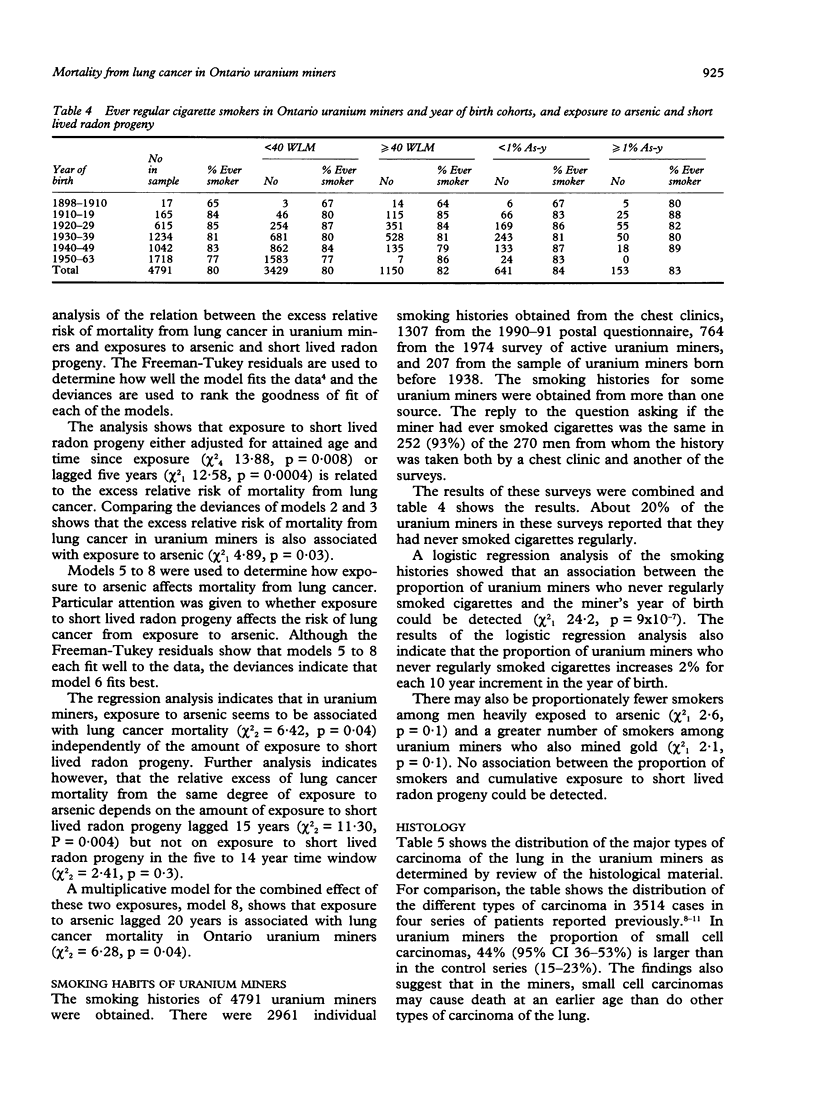Abstract
Mortality from lung cancer was greater in Ontario uranium miners than in the general male population of Ontario (observed = 152, expected = 67.6, standardised mortality ratio 225, 95% confidence interval 191-264). Part of the excess of lung cancer may be because the proportion of men who are smokers or have smoked is greater in uranium miners than in Ontario men. Smoking does not explain the whole excess. Mortality from lung cancer in Ontario uranium miners is clearly related to exposure to short lived radon progeny. The excess relative risk of lung cancer from the same degree of exposure to short lived radon progeny is greatest five to 14 years after exposure and less subsequently. It is greater in men under the age of 55 years and less in older men. Part of the excess of lung cancer mortality in Ontario uranium miners is probably also due to exposure to arsenic that occurred earlier in gold mines. In Ontario uranium miners, the lung cancer mortality from exposure to arsenic increases as the intensity of exposure to short lived radon progeny increases. This finding is consistent with the hypothesis that the risk of lung cancer from exposure to arsenic is enhanced by exposure to other carcinogens. In Ontario uranium miners, the proportion of lung cancers that are small cell carcinomas is greater than in the general population. The proportion of small cell carcinomas is especially great five to 14 years after exposure to short lived radon progeny and in men who die from lung cancer at younger ages.
Full text
PDF








Selected References
These references are in PubMed. This may not be the complete list of references from this article.
- Beard C. M., Jedd M. B., Woolner L. B., Richardson R. L., Bergstralh E. J., Melton L. J., 3rd Fifty-year trend in incidence rates of bronchogenic carcinoma by cell type in Olmsted County, Minnesota. J Natl Cancer Inst. 1988 Nov 2;80(17):1404–1407. doi: 10.1093/jnci/80.17.1404. [DOI] [PubMed] [Google Scholar]
- Cox J. D., Yesner R. A. Adenocarcinoma of the lung: recent results from the Veterans Administration Lung Group. Am Rev Respir Dis. 1979 Nov;120(5):1025–1029. doi: 10.1164/arrd.1979.120.5.1025. [DOI] [PubMed] [Google Scholar]
- Kusiak R. A., Springer J., Ritchie A. C., Muller J. Carcinoma of the lung in Ontario gold miners: possible aetiological factors. Br J Ind Med. 1991 Dec;48(12):808–817. doi: 10.1136/oem.48.12.808. [DOI] [PMC free article] [PubMed] [Google Scholar]
- Magos L. Epidemiological and experimental aspects of metal carcinogenesis: physicochemical properties, kinetics, and the active species. Environ Health Perspect. 1991 Nov;95:157–189. doi: 10.1289/ehp.9195157. [DOI] [PMC free article] [PubMed] [Google Scholar]
- Taylor P. R., Qiao Y. L., Schatzkin A., Yao S. X., Lubin J., Mao B. L., Rao J. Y., McAdams M., Xuan X. Z., Li J. Y. Relation of arsenic exposure to lung cancer among tin miners in Yunnan Province, China. Br J Ind Med. 1989 Dec;46(12):881–886. doi: 10.1136/oem.46.12.881. [DOI] [PMC free article] [PubMed] [Google Scholar]
- Valaitis J., Warren S., Gamble D. Increasing incidence of adenocarcinoma of the lung. Cancer. 1981 Mar 1;47(5):1042–1046. doi: 10.1002/1097-0142(19810301)47:5<1042::aid-cncr2820470535>3.0.co;2-5. [DOI] [PubMed] [Google Scholar]
- Vincent R. G., Pickren J. W., Lane W. W., Bross I., Takita H., Houten L., Gutierrez A. C., Rzepka T. The changing histopathology of lung cancer: a review of 1682 cases. Cancer. 1977 Apr;39(4):1647–1655. doi: 10.1002/1097-0142(197704)39:4<1647::aid-cncr2820390439>3.0.co;2-h. [DOI] [PubMed] [Google Scholar]


